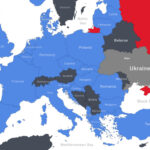
A Ukrainian soldier with the 1st Airmobile Battalion, 79th Air Assault Brigade calls out to a fellow soldier, letting the other soldier know he is set and ready to cover his movement during pairs movement training at the Yavoriv Combat Training Center on the International Peacekeeping and Security Center, near Yavoriv, Ukraine, May 15, 2017. Yavoriv CTC staff, along with mentors from the U.S. Army’s 45th Infantry Brigade Combat Team, led pairs movement training for soldiers from the 1-79th during the battalion’s rotation through the Yavoriv CTC. The 45th is deployed to Ukraine as part of the Joint Multinational Training Group-Ukraine, an international coalition dedicated to improving the CTC’s capabilities and building professionalism within the Ukrainian army. (U.S. Army photo by Sgt. Anthony Jones) www.dvidshub.net
In a little-publicized effort, NATO troops have been training Ukrainians for years for the very fight they find themselves in today. Daniel Michaels reports in The Wall Street Journal:
Through classes, drills and exercises involving at least 10,000 troops annually for more than eight years, NATO and its members helped the embattled country shift from rigid Soviet-style command structures to Western standards where soldiers are taught to think on the move.
In confounding Russian invaders today, Lt. Kulish says his comrades-in-arms “are definitely using procedures they learned during the training with NATO.”
The Western assistance, while never secret, wasn’t trumpeted to avoid riling Russia. It also remained low-key because it was a valuable source of intelligence for the U.S. and its allies. Ukraine has been fighting a shooting war with Russian-backed separatists in parts of its east for years, meaning Kyiv fields some of Europe’s most battle-hardened soldiers. Their front-line experience made them sponges for NATO training—and offered NATO commanders a window into what it would be like to fight Russia, say Western officers involved in the programs.
By the time Russia invaded on Feb. 24, training of Ukrainian forces had become so extensive that, although at least eight NATO countries participated, much of the hands-on training was being done by Ukrainian instructors. To NATO commanders, that was a sign Ukraine had internalized their teachings.
“The lesson learned is that support and help over many years had a significant impact,” says NATO Secretary-General Jens Stoltenberg.
NATO’s work in Ukraine was also more successful than comparable Western efforts in Iraq and Afghanistan. Advisers credit this to Ukraine’s relatively cohesive society and a recognized central government supported by bureaucracies that, while often inefficient and plagued with corruption, still embodied a unified state. Perhaps most significant, Ukraine had a clear foreign enemy to fight following Russia’s 2014 seizure of the Crimean Peninsula and military support for a rebellion in the country’s east.
If you’re willing to fight for Main Street America, click here to sign up for my free weekly email.





